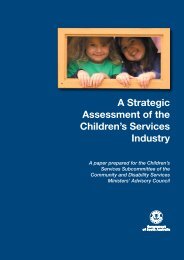Global Study On Child Poverty And Disparities (PDF) - Social Policy ...
Global Study On Child Poverty And Disparities (PDF) - Social Policy ...
Global Study On Child Poverty And Disparities (PDF) - Social Policy ...
Create successful ePaper yourself
Turn your PDF publications into a flip-book with our unique Google optimized e-Paper software.
Male Female Total<br />
Background characteristics<br />
% attendance* Number of % attendance* Number of % attendance* # of children<br />
children<br />
children<br />
Wealth index Q1 (poorest) 73.6 227 72.8 172 73.3 399<br />
quintiles<br />
Q2 80.0 181 82.5 197 81.2 378<br />
Q3 76.5 216 77.1 188 76.8 404<br />
Q4 84.1 257 85.1 190 84.5 447<br />
Q5 (richest) 88.9 305 89.3 268 89.1 573<br />
Mother Bislama 73.0 221 79.5 192 75.9 413<br />
tongue of<br />
Other 81.2 962 81.1 818 81.2 1,780<br />
head §<br />
National 80.0 1,186 80.9 1015 80.4 2,201<br />
Source: MICS 2007.* MICS indicator 55 and MDG indicator 6; (*) per cent count has been suppressed as the Figure is based on<br />
fewer than 25 unweighted cases; § eight missing cases.<br />
The Ministry of Education’s 2007 statistics<br />
indicate that net enrolment for primary-schoolage<br />
children has decreased since 2005, from a<br />
net enrolment rate of 95.1 per cent to 85.4 per<br />
cent. The male rate is slightly higher (86.2 per<br />
cent) than that for females (84.5 per cent). While<br />
net secondary school enrolment rates have been<br />
increasing, they still remain very low. <strong>On</strong>ly 46.6<br />
per cent of junior secondary-school-age students<br />
were enrolled in 2007, which is among the lowest<br />
in the Pacific. For senior secondary-school-age<br />
youth (17 to 20), only 11.7 per cent were enrolled.<br />
Analysis<br />
As mentioned above, school fees have been a<br />
major cause of low enrolments. Other reasons<br />
for low enrolment and attendance are long travel<br />
distances, poor quality teaching, inappropriate<br />
curriculum and poor condition of school facilities.<br />
Cultural traditions and kastom are also noted as<br />
reasons for low enrolment and attendance, as<br />
priority is given to domestic and agricultural tasks<br />
and family duties (ADB 2009a, p. 94). Tables 3.9<br />
and 3.10 summarize a range of factors that affect<br />
school quality and cost.<br />
Table 3.9: Primary schools, expenditures and enrolments<br />
Number of primary schools Expenditure per pupil (VUV) Number of primary enrolments<br />
2005 2006 2007 2005 2006 2007 2005 2006 2007<br />
Total 462 456 437 25,104 31,361 41,076 40,327 39,212 37,874<br />
Malampa 99 98 92 na na na 7,575 7,438 6,667<br />
Penama 68 65 65 na na na 5,450 5,134 4,982<br />
Sanma 99 99 94 na na na 7,809 7,797 7,502<br />
Shefa 83 81 80 na na na 10,467 10,195 9,940<br />
Tafea 89 89 83 na na na 7,130 6,897 7,145<br />
Torba 24 24 23 na na na 1,896 1,751 1,638<br />
na: not available<br />
Table 3.10: Primary school teachers and facilities<br />
Pupils per<br />
teacher<br />
Pupils per<br />
certified teacher<br />
Pupils per<br />
qualified teacher<br />
Teachers with<br />
qualifications<br />
Schools with<br />
piped water<br />
Schools with<br />
power supply<br />
Total 23 52 46 58% 47% 38%<br />
Malampa 22 55 47 60% na na<br />
Penama 21 68 55 57% na na<br />
Sanma 21 45 40 58% na na<br />
Shefa 27 56 50 53% na na<br />
Tafea 23 40 37 62% na na<br />
Torba 26 86 79 65% na na<br />
Source: Ministry of Education Digest, 2007.<br />
na: not available<br />
Note: Forms of power supply include generators, mains, and solar/wind/water power.<br />
67
















